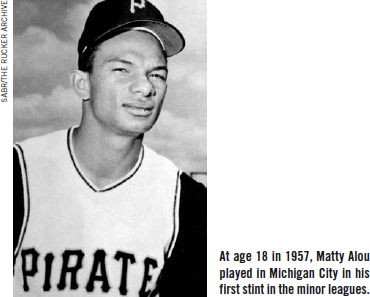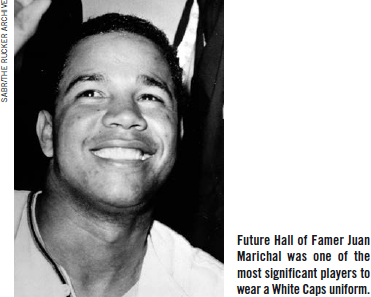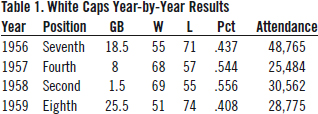The Michigan City White Caps
This article was written by Bob Webster
This article was published in The National Pastime: Heart of the Midwest (2023)
In the early 1950s, minor league baseball was in a decline. Televisions were fairly new and air conditioning became more affordable, giving people reasons to stay home. More recreational activities became available. Going to a ballpark in the evening for entertainment and to cool off wasn’t as necessary as it had been in the past. With many people moving to the suburbs, ballparks were no longer close by. There were 59 leagues and more than 400 minor league teams in the late 1940s. By the end of the ’50s, 300 cities had lost their minor league teams.1
Independent teams were the first to go. They did not have the financial backing to stay afloat on their own. The Mississippi-Ohio Valley League was a Class-D league, which had its beginnings as the Illinois State League in 1947. Following the 1955 season, the league expanded and changed its name to the Midwest League. Since the geographical footprint of the league now reached into Illinois, Iowa, and Indiana, the old name did not fit well anymore.
The Hannibal Citizens were in trouble. Known as the Cardinals in 1953 and 1954, the Hannibal, Missouri, team lost their affiliation with the St. Louis Cardinals in 1955. Even though attendance at Clemens Field (named after Hannibal native Samuel Clemens, also known as Mark Twain) increased from 33,065 in 1954 to 40,977 in 1955, the newly independent team’s existence was in jeopardy without the financial backing that came from affiliation with a major league team.
Al Shinn, a 20-year-old first baseman for the Citizens, took over as player-manager during the 1955 season. On January 29, 1955, he married Georgiana Lewis in Chicago. Georgiana’s family lived in Long Beach, Indiana, which borders Michigan City on the north/northeast side. Michigan City and Long Beach are located on the southern shores of Lake Michigan. Whenever games in Kokomo and Lafayette (Indiana) were rained out, he would visit his in-laws in Long Beach. Knowing that baseball in Hannibal was in trouble, Shinn and his brother-in-law, Bob Hood, talked about bringing baseball to Michigan City.2 Shinn and Hood took a “man on the street” poll and determined that Michigan City was open to supporting minor league baseball.3
On November 28, 1955, league directors met in Columbus, Ohio. They voted to change the name of the Mississippi-Ohio Valley League to the Midwest League, and granted Michigan City a franchise for the 1956 season, with Opening Day scheduled for April 29.4 The “White Caps,” a reference to nearby Lake Michigan and its breaking waves, became a minor league affiliate of the New York Giants. Michigan City already had a ballpark. Ames Field, a 4,000-seat park, was completed in 1939. There was room to add more seats if necessary, with a parking lot beyond the right field wall and a grassy area with playground equipment, a fountain, and tennis courts beyond the center and left field walls.
There were obstacles to playing in Michigan City. Ames Field was already scheduled heavily by youth baseball. The team’s ownership group, which was led by Shinn, hired Ralph Waterhouse as club president. Waterhouse already headed up the youth baseball leagues and only agreed to the position with the minor league club provided the new team’s schedule didn’t interfere with the youth leagues.5
There were also concerns that two big-league teams played in Chicago, only 54 miles away. It wasn’t certain that fans would attend Class-D games when the Cubs and White Sox were so close. Just two miles from the ballpark, Lake Michigan presented its own obstacle. Washington Park, at the northern edge of Michigan City, was a great place to swim, and it featured an amusement park and a zoo. The concern was that the townspeople might prefer cooling off at the lake to putting up with the heat at a ballpark.6
The attendance goal for the inaugural season was 50,000, or approximately 800 people for each of the 63 home games. Former Notre Dame football coach Frank Leahy, who lived in Long Beach, was brought in to head up advanced ticket sales.7 As promotional stunts, the team set aside certain days for citizens of various cities in the area to attend games as a group. The cities included: St. Joseph, Benton Harbor, and Niles, Michigan, along with Gary, Hammond, Valparaiso, LaPorte, and South Bend, Indiana.8
Ames Field was approaching 20 years old, and needed some sprucing up in preparation for the White Caps. It received a complete paint job, a new press box, and a screen to protect fans from foul balls. A new, covered dugout down the first base side would house the visiting team. A large board down the right field line listed the standings, and a new scoreboard, operated from the press box, sat atop the left field wall.9
Opening Day, April 29, 1956, had an interesting twist. The White Caps opened the Midwest League season in an afternoon game at Kokomo, then traveled back to Michigan City for an 8:00 rematch that same evening. Approximately 6,000 were expected to attend Opening Day at Ames Field. Mayor Fedder tossed the first pitch.
Four bands were scheduled to be in a parade that escorted the team to Ames Field. A color guard raised the flag and orchids were handed out to the first 500 ladies in attendance.10 Attendance for the 1956 season totaled 48,765, or 774 per game, so they came very close to meeting their attendance goals for their inaugural season.
Twenty-one-year-old player-manager Al Shinn led the White Caps to a 55-71 record in 1956, good for seventh place. Charlie Alsop’s 14-7 record and leagueleading 2.64 ERA earned him a spot on the All-Star team. He was the only White Caps player to make the All-Star team in 1956. Bill Redfield, sports editor for the Michigan City Post-Dispatch said in July that the club “stood a good chance of finishing on the right side of the financial ledger.” Redfield also said, “the galleries seldom have been below 600 and have surpassed 1,200 on occasions.11
In 1956, the Al Shinn-led ownership group sold the team to a group headed by M.B. Bergerson. Bergerson was president of B & K Products, the firm that ran root beer stand franchises in the Midwest.12 The 1957 club improved to 68-57. John Orsino and Manny Mota earned spots on the All-Star team. Future major leaguer Bobby Bolin led the team with 15 wins. Orsino, Mota, Bolin, Matty Alou, and Bob Farley all eventually played in the majors.
The White Caps’ best year was 1958. Former major leaguer Buddy Kerr managed the team. The shortstop had amassed a .249 batting average in his nine-year major-league career, the first seven with the New York Giants and the final two with the Boston Braves. Jose Tartabull joined Juan Marichal as the two future-major leaguers on the club. Marichal’s 21 wins and 1.87 ERA led the Midwest League. He was Rookie of the Year as well as an All-Star, and Buddy Kerr was named the league’s Manager of the Year. The White Caps won the first half of the season and Waterloo took the second half. Waterloo won the five-game championship series, 3-2.
Marichal, who would go on to a Hall-of-Fame career, was the most famous player to ever wear a White Caps uniform. Michigan City was his first assignment after being signed by the Giants. He credits White Caps manager Buddy Kerr with his early success.13
When spring training camp broke in 1958, a bus headed for Michigan City. Among the players were three Latinos and four blacks. Marichal was not introduced to racism in the farming communities of the Dominican Republic and was quite surprised to see that when the bus stopped to eat, they had to check to see if the seven dark-skinned players could eat inside with the White players. He said that Kerr always made sure that the seven were served their meal before he would eat.
In addition to his sparkling record and ERA, Marichal struck out 246 batters in 245 innings, and was the winning pitcher in both of Michigan City’s championship series victories. Despite their success, by 1958 it was apparent that the White Caps, averaging only about 500 fans per game, were not a profitable team. It was estimated that they needed around 700 fans per game to break even. According to Bill Redfield, the Michigan City newsman, the franchise was churning out some decent prospects, enough to keep the Giants happy.
Much of their success in 1958 was because of the way Kerr handled the young players.14 Things fell apart for the White Caps in 1959. On the field, their 51-74 record was good for eighth and last place in the league. Jose Tartabull did however lead the Midwest League with 106 runs scored. Rick Joseph and Wayne Schurr joined Tartabull as future-major leaguers to play for the White Caps that year.
Off the field, the Giants changed their Midwest League affiliation from Michigan City to Quincy, Illinois, for the 1960 season. Without major league affiliation, Michigan City could no longer field a team. There was a deadline of January 15, 1960, for teams to post a league membership dues of $1,000. Michigan City was not represented at a league meeting held in Davenport, Iowa, in November and did not submit the dues. The four-year run for the Michigan City White Caps was over.15
BOB WEBSTER grew up in NW Indiana and has been a Cubs fan since 1963. After moving to Portland, Oregon, in 1980, Bob spends his time working on baseball research and writing and is a contributor to quite a few SABR projects. He worked as a Stats Stringer on the MLB Gameday app for three years and is a member of the Pacific Northwest Chapter of SABR, the Oregon Sports Hall of Fame, and is on the Board of Directors of the Old-Timers Baseball Association of Portland.
Notes
1. Lloyd Johnson and Miles Wolff, “The Decline: 1952-1962,” The Encyclopedia of Minor League Baseball, Second Edition (Durham: Baseball America, 1997), 411.
2. Allan D. Shinn Obituary, https://www.legacy.com/us/obituaries/dailyjournalonline/name/allan-shinnobituary?id=14343775. Accessed February 2, 2023.
3. Dick Micell, “Michigan City in ‘Pro’ Debut,” South Bend Tribune, March 25, 1956, 39.
4. Bob Ford, “Midwest Baseball League is Formed,” Kokomo Tribune, November 29, 1955, 32.
8. Paul S. Peterson, “The Sports Scene,” The Herald Press (St. Joseph, Michigan), April 26, 1956, 8.
9. “Michigan City Prepares for Baseball Team,” Vidette-Messenger of Porter County March 10, 1956, 5.
11. Bob Barnet, “’D’ Baseball Flourishes at Michigan City,” Muncie Star, July 3, 1956, 16.
12. “Michigan City Group Buys Baseball Club,” Decatur Sunday Herald and Review, July 22, 1956, 19.
13. Juan Marichal and Lew Freedman, Juan Marichal (Minneapolis: MVP Books, 2011), 35-39.
14. Dick Micell, “Sideline Slants,” South Bend Tribune, July 27, 1958, 34.
15. Al Ney, “Midwest League 10 Teams Now, Probably 8 Soon,” The Courier (Waterloo, Iowa), November 23, 1959, 15.





